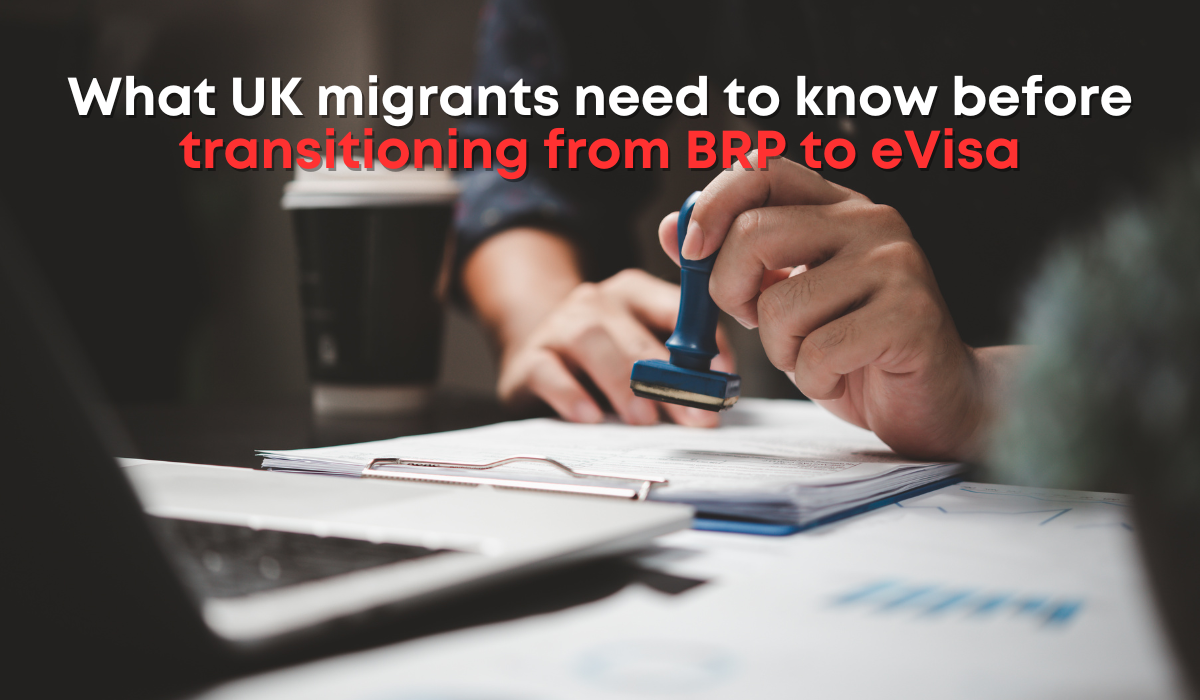The UK is undergoing a significant transition in its immigration system, moving from physical documentation to digital proof of immigration status known as eVisas. This transition, part of a broader Home Office strategy to create a “digital by design” immigration system, will see the current Biometric Residence Permit (BRP) cards expire on 31 December 2024, with eVisas becoming the standard from 1 January 2025. This shift affects millions of migrants in the UK and presents a range of challenges and considerations who are going to switch their BRP to eVisa.
What is an eVisa?
An eVisa is a digital record of an individual’s UK immigration status. This online account stores visa information such as visa type, validity period, and specific conditions attached to the individual’s stay in the UK. The eVisa system eliminates the need for physical cards, aiming to enhance security and simplify the process of updating personal and immigration information.
Who Needs to Transition to an eVisa?
If you currently hold a Biometric Residence Permit (BRP) in the UK, you will need to transition from the BRP to the eVisa system before the end of 2024. This applies to all visa holders residing in the UK, regardless of visa type or nationality. Failing to transition could result in losing your immigration status, affecting your right to live, work, or study in the UK and complicating travel or re-entry to the country.
How to Transition to an eVisa
The Home Office began the transition process in April 2024, inviting visa holders via email to set up a UKVI account. To create your account and access your eVisa, visit the UKVI website and follow the instructions to complete the account creation process. You will need your date of birth, BRP number or passport details, an active email address, and a valid phone number.
Once your UKVI account is set up, you can access your eVisa, which will display important details about your immigration status, including visa type, expiry date, and any specific conditions.
Challenges and Issues with the Transition to eVisas
The transition from BRP to eVisa is fraught with challenges, primarily due to technical issues and the scale of the process. There are concerns that the transition may not be completed in time, potentially leaving hundreds of thousands of migrants without proof of their valid status. The Immigration Law Practitioners’ Association (ILPA) has raised concerns about a potential “Windrush-style” crisis if urgent action is not taken.
Key issues include:
- Technical Problems: The eVisa system has faced technical issues that could disrupt the transition process.
- Communication Gaps: The Home Office’s method of emailing status-holders may not reliably reach all recipients, especially those with outdated contact information.
- Vulnerable Groups: Migrants with disabilities, learning difficulties, language barriers, and limited access to technology are at risk of being disproportionately affected by the transition.
ILPA Recommendations
The Immigration Law Practitioners’ Association (ILPA) has written to UKVI highlighting several issues and concerns, making the following recommendations to avert a potential Windrush-style crisis:
- Immediate Action: The Home Office must ensure that every person can prove and access their status without technical errors in any circumstance by allowing expired physical evidence of immigration status to be acceptable, and/or issuing new physical evidence of immigration status. This would prevent affected individuals from being unable to prove their rights when technology fails or is inaccessible.
- Meaningful Engagement: The Home Office should engage in informative, personalized, and tailored communication across various media, including advertisements, extensive email campaigns, and direct engagement with charities and community groups. The lessons from the EU Settlement Scheme (EUSS) and Windrush must be learned, and mistakes must not be repeated.
- Helpline: Establishing a 24/7 helpline with translation services for migrants, carriers, employers, landlords, and others to obtain certified on-the-spot confirmation of a person’s UK immigration status where the normal mechanisms fail, provide one-off assistance with transferring to eVisa, and address ongoing problems accessing status.
Medium Term Action
The ILPA has also suggested medium-term actions to further support the transition:
- Digital Tokens: Introducing digital tokens similar to the QR codes used for COVID-Status Certification, which could be accessed either without an internet connection and/or be printed out. This secure QR-based alternative aligns with recommendations from the International Civil Aviation Organisation.
Advice for Employers
Employers should be aware that BRPs will not be valid proof of right to work from 1 January 2025. They should perform follow-up online right to work checks before the end of the year if they have previously relied on a BRP as proof. Employers are also encouraged to inform their workforce about the new system of transitioning from BRP to eVisa and ensure they understand the implications.
Employers should use the Home Office’s Employer Checking Service to verify the status of workers if there is any doubt. It is also crucial to remember that workers are protected from unlawful discrimination, and any disciplinary or dismissal actions should be fully considered in light of legal implications.
The transition to eVisas represents a significant change in the UK’s immigration system. While the move aims to streamline and secure the process, it also presents considerable challenges. Migrants and employers alike must stay informed and proactive to navigate this transition successfully. If you have concerns about your immigration status or the implications for your organisation’s right to work procedures, seek professional advice to ensure compliance and avoid potential issues.
Get in touch: For a comprehensive understanding of your options or queries on UK immigration matters, contact GigaLegal Solicitors at 02074067654 or click here to book a no-obligation consultation with an immigration expert.


